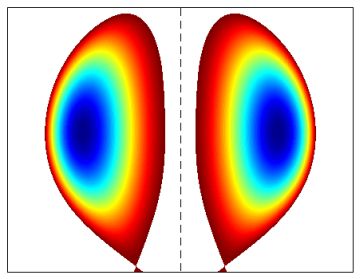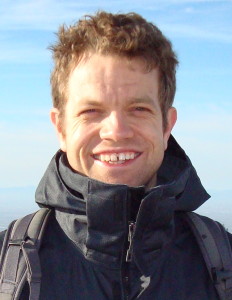Mathematicians Miranda Holmes-Cerfon and Antoine Cerfon first forged a bond as undergraduates studying abroad in Singapore. Their common love of math – but even more so of each other’s company – led them on parallel paths through graduate school and postdoctoral research.
The two finally are together as faculty, each with an appointment in the Courant Institute of Mathematical Sciences at New York University and each with a 2014 Early Career Research Program award from the Department of Energy.
Though their careers followed different trajectories, the two have influenced one another toward energy-related research. He started his doctoral training as an experimental fusion physicist at Massachusetts Institute of Technology in Cambridge and evolved into a theoretician, combining physics and applied math to study fusion theory. She started as a mathematician who has developed interests in how materials self assemble and how emergent properties can be used to harness and store energy.
Using support from her award though the Office of Advanced Scientific Computing Research, Holmes-Cerfon intends to develop a mathematical underpinning to support both theoretical and experimental research on how certain classes of molecules can be coaxed into self-assembling into useful new materials. Materials engineers are interested in using these nano- and mesoscale building blocks to make new classes of devices that can, for example, store and release energy. The science is still in its infancy and there still is a learning curve in understanding the physics operating at these scales, Holmes-Cerfon says.
“We are learning to control matter at nano- and mesoscales,” she says. “The question is: How can we design particles that spontaneously form into the structures that we want?”
At the mesoscale – an intermediate size range – the dominant force is Brownian motion, or the random movements of particles suspended in a solution, Holmes- Cerfon says. She works with colloids – sticky particles suspended in solution – as a model system. Using geometry, she seeks to portray the particles’ movements and eventually to predict how various types of molecules will cling to form large-scale materials. To do that, she’s developing computational tools to analyze the interactions and kinetics of nano- and mesoscale systems as they self-assemble through short-range interactions with their immediate neighbors.
Holmes-Cerfon describes her challenge as a search for a new mathematics to map the energy landscape these mesoscale materials inhabit and the pathways layered on top of it. The energy of atomic-scale systems often is likened to a mountain range, she says, with atoms seeking the lowest energy state in the valleys.
‘I started in an experimental lab and very quickly realized that was not for me.’
That picture doesn’t work for the systems she’s modeling. These energy landscapes are more like golf courses: relatively flat, with a few gentle undulating slopes, and with a desired energy state corresponding to the relatively small hole on the green. But instead of a golfer guiding the ball into the hole, Holmes-Cerfon’s job is to design a ball that will find it on its own. It’s a daunting concept for the weekend golfer but one that is quite plausible in Holmes-Cerfon’s conceptual landscape.
“I’m trying to find a new way to characterize and compute pathways on these types of landscapes,” she says. “To do that we have to calculate these geometrical objects that describe the landscape. I think of the landscape as a polygon with corners that are rigid clusters of molecules and then lines that are one-dimensional paths connecting the clusters and then surfaces, which are two-dimensional regions connecting the corners.”
All the possible interactions between molecules must be calculated to solve the problem. Holmes-Cerfon is working on relatively small systems with a few molecules and using a form of mathematics that calculates how spheres arrange themselves in a given space.
“This is actually a problem that pure mathematicians think about, but it’s turning out to be quite important in applied math and materials science,” she says.
Though she doesn’t do experiments, Holmes-Cerfon has collaborated with Vinothan Manoharan, a Harvard physicist interested in the physics of self-organization. Graduate student Rebecca Perry’s recent experiments in Manoharan’s lab have shown that Holmes-Cerfon’s geometrical framework works well to describe the transition rates of particles diffusing on a two-dimensional plane. Holmes-Cerfon now is expanding the framework to predict more complicated assembly pathways.
Once the basic interactions can be reliably calculated and can predict assembly, she plans to use that information to help outline building blocks that self-assemble according to specific design parameters. Such a system could be used to manufacture materials for a new generation of batteries, solar cells or materials that interact with light in specific ways, she says.
Cerfon acknowledges that his wife’s career has influenced the direction of his work.
“I started in an experimental lab and very quickly realized that was not for me,” he says. “In addition, Miranda was at NYU and I was at MIT, and I realized if I became a theorist, I could do the work from anywhere,” including on the long bus ride between New York and Boston each weekend.
Beginning with his graduate thesis, Cerfon set out to help solve the problem of sustained nuclear fusion, a controlled reaction that creates more energy than it consumes. Experimental fusion has progressed to the point where it’s possible to achieve the required temperatures and pressures, but maintaining those temperatures is difficult because energy escapes as heat.
Cerfon applied his mathematical skills to improve modeling the turbulent behavior in hot plasmas that fuel fusion reactors. The idea is to better understand how turbulence results in heat loss, but the calculations are computationally intensive.
“Some of the biggest jobs currently running on DOE supercomputers are calculating the turbulence in these systems,” he says. Known as “hero runs,” these calculations can take several days on tens of thousands of supercomputer processors. Yet they remain limited in their capacity to simulate the relevant physical processes taking place over the full duration of a fusion experiment.
Cerfon’s research focuses on two aspects: extending existing models to include more of the physical processes occurring in experiments, and implementing optimized numerical methods to accelerate the computations and improve their accuracy.
Specifically, he is developing a code that will calculate the new background magnetic configuration resulting from the plasma’s turbulent evolution. Until now, this self-consistent updating of the magnetic configuration hasn’t been done because calculating the turbulence alone is a huge challenge, Cerfon says.
He will use his early career award, funded through the Office of Fusion Energy Sciences, to write a solver based on a mathematical technique called the fast multipole method, which can be used to efficiently calculate the background equilibrium state during fusion reaction simulations. The method, invented in 1987 by NYU mathematician Leslie Greengard and Yale mathematician Vladimir Rokhlin, has been called one of the top algorithms of the 20th century, begging the question of why it has not been used before in these calculations.
“To be honest, it’s a bit tedious to code,” Cerfon says. “But the fact that it is tedious to code is no excuse for not using it, because there are great savings down the road. And the great thing is once it is done, the customer can use it without having to think about what’s in the code.”
Adds Cerfon, “My goal is to streamline these calculations so we leave some room on these supercomputers for other fields.”


